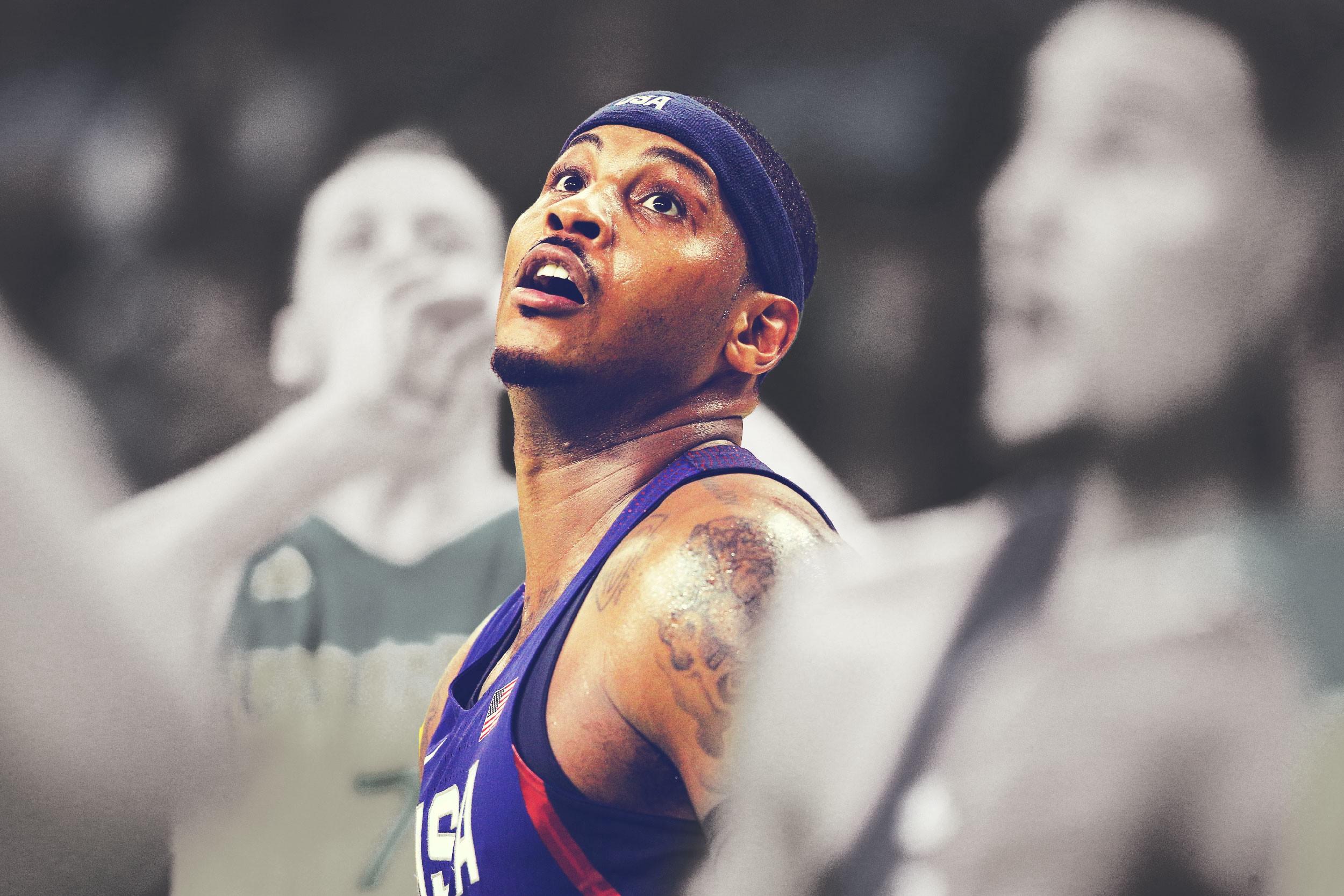Carmelo Anthony was the only thing standing between Team USA and its first loss in a decade on Wednesday. In a 98–88 victory over Australia, during which the Americans’ defense fell apart and no one could get going on offense, Carmelo was the one constant, repeatedly generating something from nothing and putting the game away in the fourth quarter with a barrage of jumpers. He went for 31 points and eight rebounds, making more 3-point shots (9-of-15) than the rest of the team combined (8-of-24). By the end of the game, he had become Team USA’s all-time leading scorer, a fitting capstone to the career of “Olympic Carmelo.”
There are a number of reasons why Carmelo has always looked better internationally than he has in the NBA. He’s surrounded by better teammates, he can exploit the lack of quality wing defenders in the international game, and the shorter 3-point line is an advantage. The biggest reason, though, is the way in which he is used. He plays exclusively as a small-ball power forward for Team USA, instead of as a hybrid small forward, as he does for the Knicks. Most players are better off when they can slide down a position, and there’s no better example than Carmelo. He becomes unguardable when he goes up against bigger and slower defenders, playing in more space than he typically gets to operate in during NBA games.
The game against Australia was the perfect example. Instead of playing against Joe Ingles on the perimeter, he was matched up against either Aron Baynes or Andrew Bogut. Neither traditional big man had a prayer of guarding Carmelo at the 3-point line. Either Anthony had room to rise and fire, or the Aussie big men were playing too close, and he could take them off the dribble and get into the paint as if they weren’t even there.
Team USA wasn’t doing a good job of moving the ball and generating open looks out of its offense, but it didn’t matter. Carmelo could create a good shot within a matter of seconds, at any point in the shot clock.
On the other side of the floor, neither Bogut nor Baynes has the type of offensive game that can really punish a smaller defender for guarding them. At 6-foot-8, 240 pounds, Carmelo isn’t easy to post up, either, because he’s always carried a lot of weight on his frame for a perimeter player and he’s more comfortable going body-to-body in the paint than chasing smaller players around the arc. Team USA’s biggest defensive issue wasn’t its lack of size, but its inability to work together as a unit. The U.S. was unable to corral the Australian guards in the pick-and-roll or keep track of their men when they switched screens. It didn’t really matter who was guarding whom, since Australia was almost guaranteed to get an open look if it ran its offense for long enough.
Bizarrely enough, that ended up working in Team USA’s favor on Wednesday. The entire point of playing traditional big men is to protect the rim and prevent easy scoring chances, but Team USA’s defense was so bad that there was no real downside to playing progressively smaller lineups as the game went on. Mike Krzyzewski closed the game with Carmelo as the 5, next to Kevin Durant, Paul George, Klay Thompson, and Kyrie Irving. If Coach K couldn’t field a lineup that could stop Australia, he was going to play an unstoppable lineup too. The Americans’ biggest personnel advantage at the Olympics is tall, athletic wings who can shoot off the dribble, so why not play as many of them as possible?
The best international teams can field NBA-caliber guards and big men, but no one else in the world can regularly produce 6-foot-8 combo forwards. What makes Team USA nearly unbeatable is its versatility: The Americans can field lineups composed entirely of wings who can play inside and out on both sides of the ball. Despite its size advantage up front, Australia couldn’t keep the U.S. off the offensive boards. Team USA had 21 total offensive rebounds from 10 different players on Wednesday.
If the Americans are making their 3-point shots, there’s nothing anyone in Rio can do to beat them. Even when they are missing them, the number of long rebounds those misses generates can keeps them in the game. There’s just no other team in the field that can mitigate the man-power advantage that Team USA has at the wing positions. Coach K will likely shrink the rotation going forward to give more minutes to Carmelo, Durant, Thompson, and George. We will probably see less of non-shooting wings like DeMar DeRozan, who had the worst plus/minus numbers in the game against Australia (minus-10 in three minutes).
Coach K has the lineup with Carmelo at the 5 in his back pocket — a Team USA twist on the Warriors’ Lineup of Death. Carmelo hugely benefits from playing next to wings who can space the floor, and he should continue to see advantageous matchups for the rest of Team USA’s time in Brazil.
It won’t be the same when he’s playing with the Knicks, especially not if he spends a lot of time in traditional lineups with Joakim Noah at the 5 and Kristaps Porzingis at the 4. The older he gets, the more incapable he will be of guarding on the perimeter, and the logic of playing him down a position will become inescapable. Paul Pierce played at a high level during his one season with the Wizards, at the age of 37, by sliding down to PF; Richard Jefferson helped swing this year’s NBA Finals by doing the same thing at 35. Carmelo is still only 32. This is the last dance for Olympic Carmelo, but the player we are seeing on this international stage could still be a force in the NBA for a long time to come.


